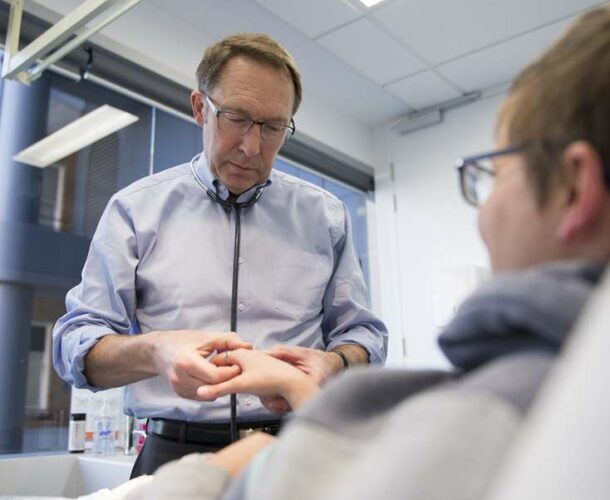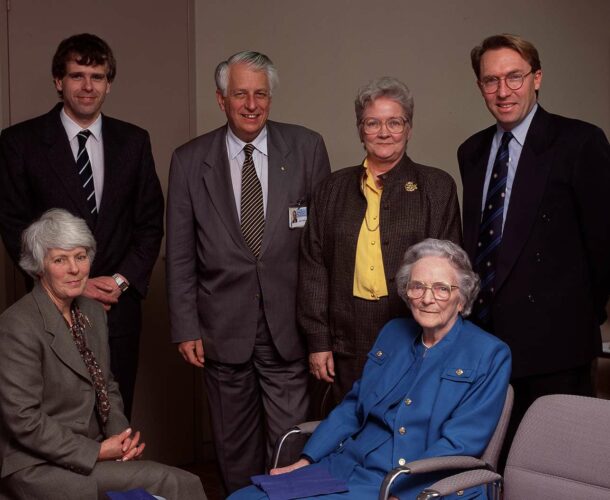The blockbuster narrative of the second half of the Walter and Eliza Hall Institute’s century-long story is Professor Don Metcalf’s discovery of colony stimulating factors (CSFs), and the lifesaving benefits that flowed from that insight to millions of cancer patients around the world.
But there are many other still evolving chapters in the story of CSFs, proteins that control how blood cells form and do their jobs. One of those chapters is defined by the work of rheumatologist and researcher Professor Ian Wicks.
Drawn to rheumatology
Wicks was drawn to rheumatology partly as a consequence of observing his grandmother’s endurance of arthritis, and partly out of a fascination with immunology. Clinical practice in rheumatology appealed as a kind of “applied immunology”, but as his training came to an end in the mid 1980s, curiosity got the better of him.
“At that point, I couldn’t see myself just going into clinical practice. I wanted to understand more about the biological basis of the diseases that I was treating,” Wicks recalls.
He started investigating his options to go deeper, but “in Sydney at that time there weren’t really any major medical research institutes that would be the equivalent of the Walter and Eliza Hall institute. Most of the research was being done within hospitals and universities.” While some were doing impressive work, their scope was limited by the lack of resources.
So with the support of his mentors, Wicks headed for Melbourne with a view to picking up techniques and skills and bringing them back to Sydney.
The molecular biology explosion
But he arrived in the heat of the molecular biology explosion, and there was no going back. Wicks signed on for a PhD in Professor Andrew Boyd’s laboratory. “My project was to clone a gene, which in those days was a very big challenge. Luckily, we identified one of the first members of a new family of genes that has turned out to be involved in cell positioning during development and cancer. It was all very exciting, and great training.”
Wicks hadn’t lost sight of his ambitions to deliver therapies for debilitating conditions such as rheumatoid arthritis, a chronic inflammatory disease that is caused by the immune system attacking joints and other tissues. It afflicts around 250,000 Australians.
Acquiring a molecular biology toolkit and a clinician’s experience would put him on that path. “I was always hoping to marry the two things and rheumatology was in need of those skills.”
Wicks went to the US as a postdoc, gaining more understanding of animal models of inflammatory and autoimmune diseases. Then director Professor Gus Nossal had been fostering a relationship between the Walter and Eliza Hall Institute and the John T Reid Charitable Trusts to establish a new effort in arthritis research at the institute.
Nossal kept in touch and offered Wicks a junior research position with Professor Len Harrison in the Autoimmunity division, so Wicks found his way back to Melbourne and a career as a clinician-scientist.
A defining influence
“So much of what you do [in research] depends on the mentors and advice you encounter. Here, Gus Nossal was really encouraging, as were Len Harrison and Richard Larkins at the Royal Melbourne Hospital.”
Wicks observes that many institute folk tell similar stories of Nossal’s defining influence. In the uncertain world of research, such support is crucial, he says. “If no one is even discussing that next potential step, it is much more daunting. Gus has always been great at matching individuals with opportunities.”
Wicks’ mentor in the US, Professor Denis Carson, had had always been impressed with the Walter and Eliza Hall Institute’s work and believed the inflammatory and immune systems were intimately related. “And given that haemopoiesis was such a strength at the institute, he encouraged me to think about combining all those things.” This became Wicks’ major area of focus.
“Because of the molecular biology revolution, we had the ability to identify and isolate individual cytokines [proteins] – these inflammatory mediators that allow the cross talk between cells within the immune system – and really define their contribution.”
Rheumatoid arthritis treatment in trials
Professor John Hamilton and Dr Ian Campbell at the University of Melbourne had already begun work on CSFs and arthritis using ‘knockout’ mice, in which the DNA had been engineered to remove one of the CSF genes. These mice, generated initially at the Ludwig Institute in Melbourne, became a very powerful tool for investigating disease models in the absence of specific genes.
Hamilton’s group established that in the absence of one of the CSFs – GM-CSF – arthritis in the mouse model was profoundly reduced. Wicks explains that the receptor for GM-CSF, the lock and key mechanism that allows GM-CSF to bind specific receptors on the surface of cells, was also cloned at the Walter and Eliza Hall Institute by Professor Nick Nicola and Dr David Gearing from the Metcalf team.
In order to translate findings on the role of GM-CSF in arthritis, Wicks initiated a partnership between the Walter and Eliza Hall Institute and AMRAD, one of Australia’s first biotechnology companies, to develop an antibody to block GM-CSF binding to its receptor.
The team collaborated with AMRAD (now CSL) and Cambridge Antibody Technology (now MedImmune, a wholly owned subsidiary of AstraZeneca) to develop the first fully human anti-GM-CSF receptor antibody, mavrilimumab. MedImmune, which has a licence agreement with CSL, is leading the clinical studies.
“This was the start of the clinical trials that are now showing such promise,” Wicks says.
“It is fantastic news and a very Australian story of discovery and clinical translation. The drug is a classic example of a clinical development that was possible due to basic discoveries and research at the Walter and Eliza Hall Institute and Parkville precinct partners. It is also testament to long-term philanthropic support from the John T Reid Charitable Trusts that has enabled my laboratory to conduct this research.
“The GM-CSF work continues, and may have implications for other autoimmune diseases, such as multiple sclerosis.”
New roles for CSFs in lupus and vasculitis
Wicks’ lab is today busy exploring roles for the CSFs and their receptors in a wide range of inflammatory diseases, including systemic lupus erythematosus and vasculitis. Excitingly, two major projects that target the receptors for G-CSF and multi-CSF (otherwise known as IL-3) have developed into collaborations with Australia’s leading biotechnology company, CSL.
Wicks now has a joint appointment as head of the institute’s Inflammation division and head of the Rheumatology Unit at The Royal Melbourne Hospital. “As rheumatologists what we deal with day in and day out is uncontrolled inflammation leading to tissue damage. So the principles applying to a disease like rheumatoid arthritis should apply to a wide range of inflammatory diseases.”
There is potential for many more chapters to be written in the CSF story.









